
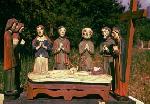

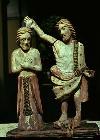
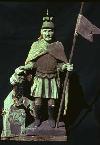



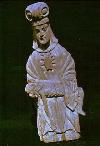
|
FOLK SCULPTURE
Wood sculpture is one of the most popular folk art branches
in the past and in the present. Until Soviet occupation, this branch was
exclusively sacral, subjects were selected from Catholic church teachings,
history and iconographies. Prayer book illustrations, various holy pictures,
devotionals and especially Lithuanian church art were samples to country
sculptors. This example was originally supplemented by written sources
- the Bible, especially appreciated lives of Saints, hymns ( sung during
various occasions, however most related to funeral rites ). Folk sculptors
created thousands of sculptures ( all polychromatic ), monumental forms,
with simple expressions, moderate and showing big emotional stress. These
sculptures ( often severe ) were placed onto crosses and into chapels.
Most of them not large ( 20-40 cm. tall, some statues were 1-1.5 m. tall
).
There are several large groups - Christ's, Virgin Mary's
and Saints'. In the first group, prevails the theme of suffering ( Crucified,
Nazarene, Crucifix, Sorrowful, Pieta ). Among the most popular saints are
John Nepomukas, John the Baptist, George, Anthony, Izidor, Agnes, Barbara
and Ann. Twenty other, rarer sculptures can also be found. A separate group
is made of traditional Stations of the Cross sculptures, found in village
churches and in chapels. There was an abundance of folk sculptures in the
19th century, all the artful features were maintained until the middle
of this century, until the natural development of this branch was cut off
by Soviet occupation. Many sculptures, together with crosses and wayside
chapels were destroyed, many fell into decay, some found place in museums,
some have been preserved in natural surroundings until today. The years
after the war, until the rebirth of Lithuania can be considered as full
of secular content, folk sculpture's rise and development years. Themes
of secular fret works - work, life, holidays, folklore ( especially heroes
of legends and fairy tales ), belles-lettres ( most books about country
characters ), mythology, ethnography, various Soviet life actualities and
war. Quite uncommon to traditional folk sculpture - humorous, satirical
sculptures and compositions to which are given not only vital types but
folklore characters, devils' and witches' shapes. During that period, no
color was added to the sculptures - carvers' attention was directed to
beauty of wood surfaces and revealing expressiveness, figure's monumental
static expression, changes in movement dynamics, various deformations,
origin of decorative elements.
Large number of sculptures created in the fifties and
seventies ( designated for exhibits and as souvenirs ), did not meet the
art quality of works of ancient folk craftsmen, however, this period created
numerous great folk talents. Among them Lionginas Ðepka, the first
to be mentioned, created sacral themes, distinctly joined sculptural plastics
with ornaments ( continuous exposition of his works is at the Rokiðkis
Museum of Regional Ethnography ). Interesting nature works are left by
A.Mockus, S.Riauba, somewhat later came forth the talent of I.Uþkurnis
and many others.
From 1988, when rebirth of Lithuania began, there were
no more restrictions, many secular and sacral carvings were created, Catholic
theme sculptures and some repetitions imitating classic cultural heritage
or reflecting craftspeople's efforts to create distinctly traditional,
sacral interpretations. During recent years, there have been two sculptural
subject layers - sacral and secular. I.Uþkurnys and V.Valiukevièius,
G.Dudaitis and R.Butkuvienë, A.Jusevièius and A.Skiesgilas,
A.Petrulis and A.Tarisius, K.Nemanis and L.Perekðlis - a small number
of today's talented craftspeople, whose works are distinct traditional
continuance, evidencing the vitality of this branch of folk art, integration
into present day art and culture development.
In Lithuania, stone sculptures' traditions are not as
developed as wood sculptures, but there were and are some interior stone
sculptures, mainly in exhibition halls, those outdoors are mainly of commemorative
nature. According to many views, stone sculptures are closely related to
wood sculptures.
Most distinct, present day sculptors were J.Liaudenskis
and J.Adomaitis ( both are dead ). There are several young stone sculptors,
taking an active part in exhibits.
|







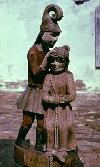

|

















